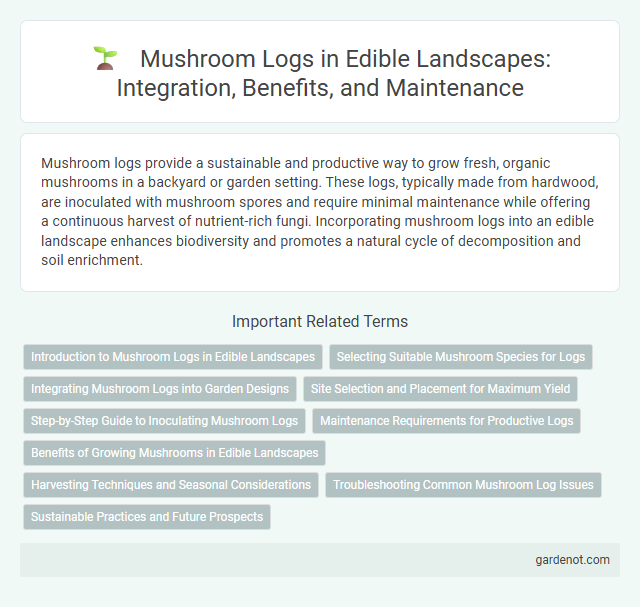Mushroom logs provide a sustainable and productive way to grow fresh, organic mushrooms in a backyard or garden setting. These logs, typically made from hardwood, are inoculated with mushroom spores and require minimal maintenance while offering a continuous harvest of nutrient-rich fungi. Incorporating mushroom logs into an edible landscape enhances biodiversity and promotes a natural cycle of decomposition and soil enrichment.
Introduction to Mushroom Logs in Edible Landscapes
Mushroom logs serve as a sustainable and productive component in edible landscapes by cultivating gourmet fungi such as shiitake and oyster mushrooms directly on hardwood logs. These logs provide a natural substrate that mimics forest environments, enhancing biodiversity and soil health while offering fresh, nutrient-rich mushrooms for homegrown consumption. Integrating mushroom logs into edible landscapes supports ecological balance and diversifies food production without requiring additional garden space.
Selecting Suitable Mushroom Species for Logs
Choosing the right mushroom species for logs depends on factors such as the local climate, type of wood available, and desired mushroom variety. Shiitake (Lentinula edodes) thrives on hardwood logs like oak and maple, making it a popular choice for temperate regions. Oyster mushrooms (Pleurotus ostreatus) grow quickly on a wider range of hardwoods and tolerate various conditions, ideal for beginners and diverse landscapes.
Integrating Mushroom Logs into Garden Designs
Mushroom logs provide a sustainable and productive element when integrated into garden designs, enhancing biodiversity and soil health while offering fresh, homegrown fungi. Placing mushroom logs in shaded, moist areas of the garden encourages optimal mycelium growth, making them a versatile addition to edible landscapes. These logs complement other crops by recycling nutrients and supporting natural pest control, creating a balanced and thriving garden ecosystem.
Site Selection and Placement for Maximum Yield
Selecting a shaded, moist site with well-drained soil is essential for optimal mushroom log placement, as consistent humidity and indirect sunlight promote mycelium growth. Position logs away from strong winds and direct exposure to intense sun to maintain moisture levels and prevent drying. Placing mushroom logs on slightly elevated areas or using supports improves air circulation and reduces contamination risks, boosting overall yield.
Step-by-Step Guide to Inoculating Mushroom Logs
Inoculating mushroom logs begins with selecting freshly cut hardwood logs, ideally 3-8 inches in diameter, cut within two weeks to maximize spawn success. Drill holes evenly spaced along the log, insert mushroom spawn dowels, and seal with food-grade wax to protect against contamination and moisture loss. Store the inoculated logs in a shaded, humid environment for 6-18 months to allow mycelium colonization before harvesting mushrooms.
Maintenance Requirements for Productive Logs
Mushroom logs require consistent moisture levels, ideally kept damp but not waterlogged, to promote healthy fungal growth and maximize yield. Regular monitoring for pests and contaminants, coupled with maintaining appropriate shade and airflow, ensures productive logs remain vibrant and effective. Periodic inoculation refreshment or supplementation can extend the fruiting period and improve overall mushroom quality.
Benefits of Growing Mushrooms in Edible Landscapes
Growing mushrooms on logs in edible landscapes enhances biodiversity by introducing natural decomposition processes that enrich soil health and nutrient cycling. Mushroom logs provide a sustainable, low-maintenance source of fresh, organic fungi such as shiitake and oyster mushrooms, which improve food security and dietary diversity. This method supports ecosystem balance by offering habitats for beneficial microbes and insects, thereby promoting overall garden resilience.
Harvesting Techniques and Seasonal Considerations
Harvesting mushroom logs requires careful timing, typically when caps fully expand but before spores release, ensuring optimal flavor and texture. Seasonal considerations favor cooler, shaded environments in spring and fall, as high temperatures and direct sunlight can hinder mushroom growth. Regular moisture monitoring and gentle twisting or cutting technique prevent damage, promoting sustainable yields from the edible landscape.
Troubleshooting Common Mushroom Log Issues
Mushroom log troubleshooting often centers on issues like contamination, inadequate moisture, and insufficient light, which can hinder fungal growth. Maintaining optimal humidity levels around 80-90% and keeping the log in indirect sunlight promotes healthy mycelium development. Removing mold or competing fungi promptly and ensuring proper air circulation prevents common cultivation problems, enhancing mushroom yield.
Sustainable Practices and Future Prospects
Mushroom logs offer a sustainable method for cultivating diverse edible fungi by utilizing recycled hardwood and organic agricultural waste, reducing landfill contributions and promoting carbon sequestration. These logs enhance soil health through natural nutrient cycling and require minimal water and energy inputs, aligning with eco-friendly agricultural models. Future prospects include integrating mushroom log cultivation with agroforestry systems to boost biodiversity, improve food security, and advance climate-resilient farming practices.
Mushroom log Infographic

 gardenot.com
gardenot.com